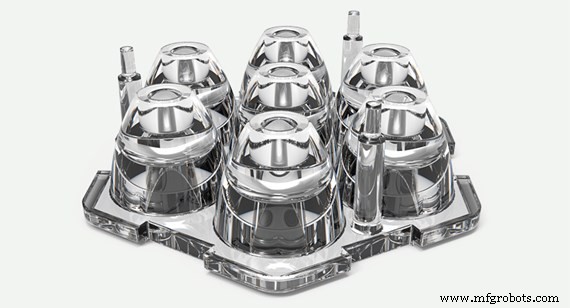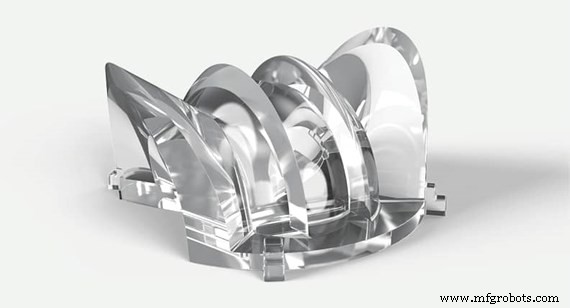Optischer flüssiger Silikonkautschuk:Eine neue Vorrichtung in der Formgebung

Wir bieten viele Fertigungsverfahren und Materialien für Prototypen- und Serienteile an. Aber ein Prozess hat ein Material, das sich von den anderen unterscheidet, optischer flüssiger Silikonkautschuk (OLSR). OLSR ist ein fortschrittliches Material mit vielen Eigenschaften, die es zu einer bevorzugten Materialwahl gegenüber Polycarbonat (PC) und Acryl (PMMA) für Beleuchtung und optische Teile machen. Hier sind einige der Vorteile, die OLSR bietet:
Lichtdurchlässigkeit
Die Lichtdurchlässigkeit geht verloren, wenn Licht durch ein Material geht. PC, PMMA und sogar Glas weisen einen Lichtverlust auf, wobei Glas bis zu 95 % behält, PMMA etwa 93 % und PC zwischen 88 und 90 %. Wenn Ihr Produkt ein durchsichtiges PC- oder PMMA-Teil erfordert, können Sie die Lichtdurchlässigkeit mit OLSR verbessern, das eine Lichtdurchlässigkeit von bis zu 94 % beibehält. Wie sieht es mit dem Brechungsindex aus? OLSR hat einen niedrigen Brechungsindex von 1,42 im Vergleich zu PC und PMMA, die bei 1,58 bzw. 1,49 liegen.
| Silikon | PC | PMMA | Glas | |
|---|---|---|---|---|
| Lichtdurchlässigkeit | 94 % | 88–90 % | 93 % | 95 % |
| Brechungsindex | 1.42 | 1.58 | 1.49 | 1.52 |
| UV-Beständigkeit | Hoch | Niedrig | Mittel | Hoch |
| Chemische Beständigkeit | Hoch | Mittel | Niedrig | Hoch |
| Temperatur | >150 °C | 120 °C | 90 °C | >200 °C |
| Gelb | Nein | Ja | Ja | Nein |
| Mikrodetail | Ja | Nein | Nein | Nein |
| Dicker Teil | Ja>1 Zoll. | Nein | >PC | Ja |
| Minimum Part Thickness | <0.020 in. | 0.040 in | 0.040 in | - |
Still another advantage is the non-yellowing factor. Thermoplastics without additives are not UV resistant, which means the parts could yellow and degrade over long exposures to lights and sunlight. OLSR is non-yellowing so it’s great for outdoor fixtures exposed to harsh environments. Heat and Chemical Resistance Because OLSR is durable under temperatures that may be close to exceeding 300°F (150°C), and able to withstand many chemicals that may break down thermoplastics, you can use OLSR in high-power light fixtures, solar power, outdoor fixtures, LED lighting, cleaning fixtures, and many other environments where PC and PMMA may fail.

Injection Molding Resilience
In plastic design, thick and thin parts are not easily achieved without sacrifice. That doesn’t necessarily ring true with OLSR design. You can achieve thick and thin geometries that oftentimes can be as thin as 0.010 in. (0.25mm) and as thick as 2 in. (50mm), all within the same part geometry because you don’t have issues with material flow, sink, or voids.
OLSR is extremely resilient against the molding issue that frequently create problems with thermoplastics, including the ability to create micro details. You also can design in negative draft angles without the need for expensive tooling that normally requires lifters, collapsible cores, and side-actions.
When to Use
As you learn about the benefits of OLSR, the applications where you can use OLSR are numerous:
- Reducing part count in your design with built-in gaskets
- Lenses of all types
- Lightpipes or guides
- Marine and wet environments
- Outdoor and indoor light fixtures
- Low- and high-heat environments
- High impact parts
To learn more about optical liquid silicone molding and other molding, machining, and 3D printing services at Protolabs, visit protolabs.com . You can also contact us at [email protected] or 877.479.7541 to speak with one of our knowledgeable applications engineers.
Industrietechnik
- Spritzgießen mit 3D-gedruckten Formen:Laden Sie unsere neue technische Studie herunter
- Blog:Spritzgießen von Flüssigsilikonkautschuk
- Materialien:Neue LSRs mit optischer Klarheit und Nylonbindung
- Spritzgießen:Neuer kleiner 6-Achsen-Roboter
- Spritzguss:Neue Roboter auf der Fakuma
- Spritzguss:Neue Modelle für wirtschaftliche Roboter
- Spritzguss:Neuer Kommissionierer, Roboter und Kartonpacker
- „Cobot“-Formungsassistenten stellen sich neuen Herausforderungen
- Spritzguss:Drei neue Maschinenlinien und ein Debüt bei Robotern
- Spritzguss:Neue Roboter auf der K 2019



